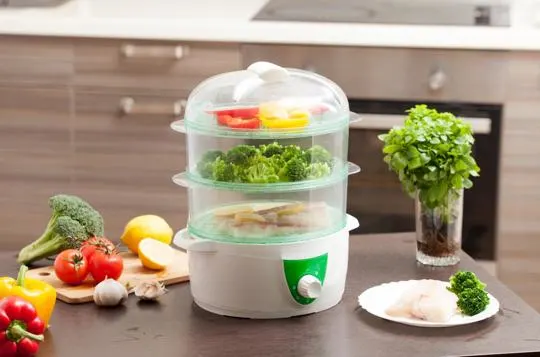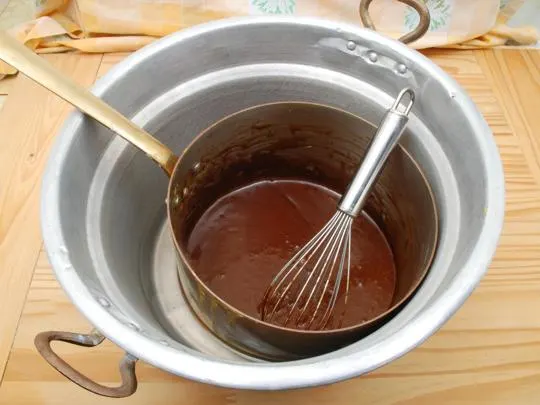Summary of key points
The primary difference between a double boiler and a steamer concerns their cooking methods and purposes. A double boiler consists of two pots where one fits inside the other; the bottom pot holds boiling water, while the top pot uses the steam for gentle cooking, ideal for melting chocolate or making custards. A steamer, however, directly cooks food with steam from boiling water below, perfect for vegetables and dumplings, maintaining nutrients and texture without direct contact with water (Source).
Ever stared at your kitchen gadgets and wondered what on earth the difference is between a double boiler and a steamer? We’ve been there.
The kitchen can sometimes feel like a battleground, especially if you’re unsure which weapon to wield. Let’s not even get started on the time we tried to steam broccoli and ended up with soup instead. Yep, that happened.
Here’s the lowdown. A double boiler gently coaxes chocolate into melting without turning it into a gloopy mess. Meanwhile, a steamer keeps our veggies crisp and bright, not mushy.
We’ve all faced the dilemma of choosing the right tool for the job. And by “job,” we mean avoiding another kitchen disaster. Trust us, there’s a way to ensure your food comes out looking and tasting as it should.
Understanding these two can be a game-changer for your cooking. No more broccoli soup, unless that’s what you’re going for.
What is a Double Boiler?

A double boiler is a kitchen device with two nested pots.
The lower pot contains water and the upper pot holds the food to cook.
It is generally used to heat or melt food like chocolate or sauces without burning them.
The steam from the boiling water in the bottom pot provides indirect heat to the top pot.
This ensures that the food is heated gradually and evenly.
The double boiler gives precise temperature control, making it ideal for tasks needing gentle cooking.
The steam prevents direct contact with high temperatures, stopping burning or overheating.
It is great for melting chocolate, making custards, and preparing sauces.
Benefits of a double boiler include steady and consistent temperature throughout the cooking process.
This guarantees that delicate ingredients are heated slowly and evenly.
It ensures smooth textures and prevents curdling or separating.
Plus, a double boiler can be used to make skincare products or melt wax for crafts.
It is a useful tool for various applications beyond the kitchen.
To sum up, a double boiler is a handy kitchen device that uses indirect heat from simmering water to provide gentle and controlled cooking.
Its temperature control and even heat distribution make it excellent for tasks needing careful heating or melting of delicate ingredients.
What is a Steamer?

Steamers are a great kitchen tool.
They come in different sizes and designs, but they all use the same process.
Water is heated to create steam, which cooks the food.
Steamers can be used to cook a variety of things like veggies, fish, dumplings, and even desserts.
A big benefit of steaming is that it preserves the natural flavors and nutrients.
Plus, it’s a healthier way to cook as it doesn’t require too much heat or oil.
It’s also easy to use and doesn’t need a lot of supervision.
Plus, you can cook multiple dishes at once with steamers.
Steaming is very versatile.
Bamboo steamers are great for dumplings and buns.
Electric and stovetop steamers are good for larger batches.
In conclusion, steamers are an essential kitchen appliance.
They make cooking healthy and convenient.
With steaming, you can create delicious meals that are nourishing.
So why not give steaming a try?
Differences Between Double Boiler and Steamer

Double boilers and steamers may look alike, but they differ in purpose.
Design and Functionality
Design and functionality are super important when comparing double boilers and steamers.
Both appliances serve different purposes, but their main aim is to effectively cook food.
Double boilers are designed with two compartments.
The bottom has water, while the top contains the food.
The boiling water cooks the food in the upper part, avoiding high temperatures.
This guards delicate ingredients from burning.
Steamers, on the other hand, have a simpler design.
They only have one chamber for water to boil and create steam.
This steam then cooks the food placed above it.
This helps preserve nutrients and flavors, great for health-conscious people.
Plus, double boilers usually have adjustable temperature settings for precise control.
This is great when dealing with temperature-sensitive ingredients like chocolate or custards.
Steamers can’t do this; they rely entirely on steam to cook food evenly.
Double boilers and steamers both have advantages.
Double boilers are great for melting things like chocolate or butter, as there’s no direct heat.
They also work well for cooking slow dishes on low heat.
On the other hand, steamers are versatile as you can cook multiple foods at once.
Some come with timers, making it easy to ensure the right cooking times.
Usage and Cooking Techniques
Double boilers and steamers both have unique advantages.
Boilers are good for delicate ingredients that need gentle heat, such as melting chocolate or making custards.
The indirect heat from the water bath stops food from burning or sticking.
Steamers are great for keeping vitamins and minerals in vegetables and seafood by cooking them quickly in their own steam.
These methods also differ in versatility.
Boilers can be used on the stovetop or over larger pots.
They have a bigger capacity, so you can make sauces, soups, and reheat leftovers.
Steamers come in various forms, like bamboo baskets and electric models with multiple compartments.
You can steam lots of different foods at once, making meal prep easier.
Double boilers and steamers also vary in terms of convenience.
Boilers require more effort to set up and maintain water levels.
However, they offer precise temperature control.
Steamers are simple – just add water and place the food on top.
Types of Foods Suited for Each Method
Cooking and choosing the right method? It can make a big difference.
A double boiler or a steamer? Both have their pros.
Double boilers are great for delicate foods that need gentle heating.
Melting chocolate, making custards and sauces like hollandaise or béarnaise? Perfect.
The simmering water prevents scorching and curdling, for smooth dishes.
What about steaming? It’s ideal for cooking veggies, seafood and meats.
The boiling water circulates and cooks the food evenly, keeping its flavor and nutrients.
Steaming also preserves its freshness and adds a subtle taste.
Certain foods are better for each method.
Delicate desserts like puddings and creams need double boilers.
Vegetables, such as broccoli, carrots and asparagus, are perfect for steaming.
Dumplings are yummy when steamed.
Fish fillets? They’ll cook perfectly, without drying out or overcooking.
Remember these methods when cooking.
Double boilers give delicate desserts and sauces a smooth texture.
Steaming keeps foods’ natural flavors and nutrients, while cooking evenly and retaining textures.
Elevate your culinary creations.
Moisture Control and Texture
Double boilers and steamers both have unique advantages when it comes to texture and moisture control.
Double boilers offer gentle, even heat distribution, perfect for achieving creamy textures in delicate dishes like custards or chocolates.
The indirect heat also allows for precise temperature control and reduces the chances of overcooking.
Steamers, on the other hand, use steam to cook food.
This helps retain natural moisture, making dishes moist and succulent.
Veggies cooked in a steamer also stay vibrant and tender, while preserving their nutrients.
Additionally, steamers provide a distinctive texture.
Circulating steam ensures even heat distribution for perfectly cooked veggies with a crisp yet tender bite.
In conclusion, both double boilers and steamers have their own advantages.
Ultimately, it depends on your culinary preferences and specific cooking needs.
Similarities Between Double Boiler and Steamer

Double boilers and steamers have a few things in common.
They are both must-have kitchen items for cooking and heating food.
Yet, they each have unique features.
One shared trait is the use of indirect heat.
This means neither appliance exposes food to extreme temperatures.
In double boilers, steam from the lower pot warms the upper pot’s contents.
Steaming works similarly, with boiling water providing the steam to cook food in a separate container.
These two tools also work well with delicate ingredients.
They heat with care, protecting flavor, texture, and nutrition of ingredients like chocolate or seafood.
You can use a double boiler to melt chocolate deliciously or steam veggies for a nutritious side dish.
Yet, steamers are even more versatile.
They can cook many types of food.
Steaming retains nutrients and brings out natural flavors of vegetables, meat, seafood, and even dumplings.
With adjustable settings and multiple compartments, steamers give you more control in the kitchen.
Benefits of Using a Double Boiler and Steamer
Double boilers and steamers bring many benefits to your cooking.
They give convenience, accuracy and versatility.
A double boiler is great for cooking delicate food like custards and sauces with no risk of burning.
The indirect heat distributes evenly, making a smooth texture.
It’s also good for melting chocolate or butter without lumps.
Steamers let you make meals with little fat.
You can steam vegetables, fish or poultry, keeping their natural nutrients while adding flavors.
Reheating leftovers is simple too because the steamer keeps the original texture and taste.
Plus, they’re easy to clean as no grease builds up.
Double boilers can act as makeshift bain-maries, keeping dishes warm until it’s time to serve.
Some even have multiple pans for cooking different things simultaneously.
With steamers, you can multitask and steam different food at different levels in the same appliance, saving time and energy.
To sum up, double boilers and steamers make cooking easy.
They give precise temperature control, healthy cooking methods, multitasking capabilities, and no need for oils or fats.
Upgrade your cooking with these kitchen tools to get great taste and nutrition in your meals.
When to Choose a Double Boiler Over a Steamer and Vice Versa
When picking between a double boiler and steamer, there are factors to consider.
A double boiler is great for precise temperature control.
It’s great for melting soft ingredients, like chocolate, or for low-heat sauces.
But if you want to keep veggies and seafood flavors & nutrients, a steamer is the way to go.
Steaming locks in moisture & nutrients, plus it doesn’t need oil or fat.
Now you know which one to choose.
Conclusion
In the end, I think it’s fair to say that both double boiler and steamer methods offer a reliable and easy way to cook your food.
They both have their own pros and cons depending on what you are cooking, but ultimately it is up to you to decide which one works best for your needs.
If precision is important for making delicate sauces or desserts, then a double boiler is ideal.
On the other hand, if you’re looking for a quick and hassle-free way of preparing vegetables, then the steamer can be far more practical.
Ultimately, the key thing is to find out what works best in terms of speed, ease of use and the results you get from either method.
Whatever process you decided to go with, make sure you are using quality ingredients and prepared correctly for even better results.
After all, there’s nothing better than when your dish comes out just how you envisioned it.

Leave a comment